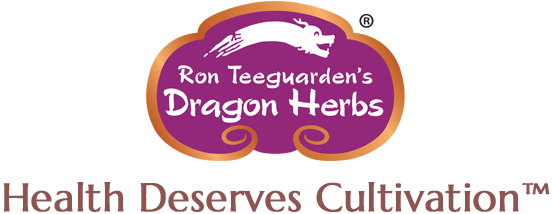Call Our Herbalists
Herbal Consultations
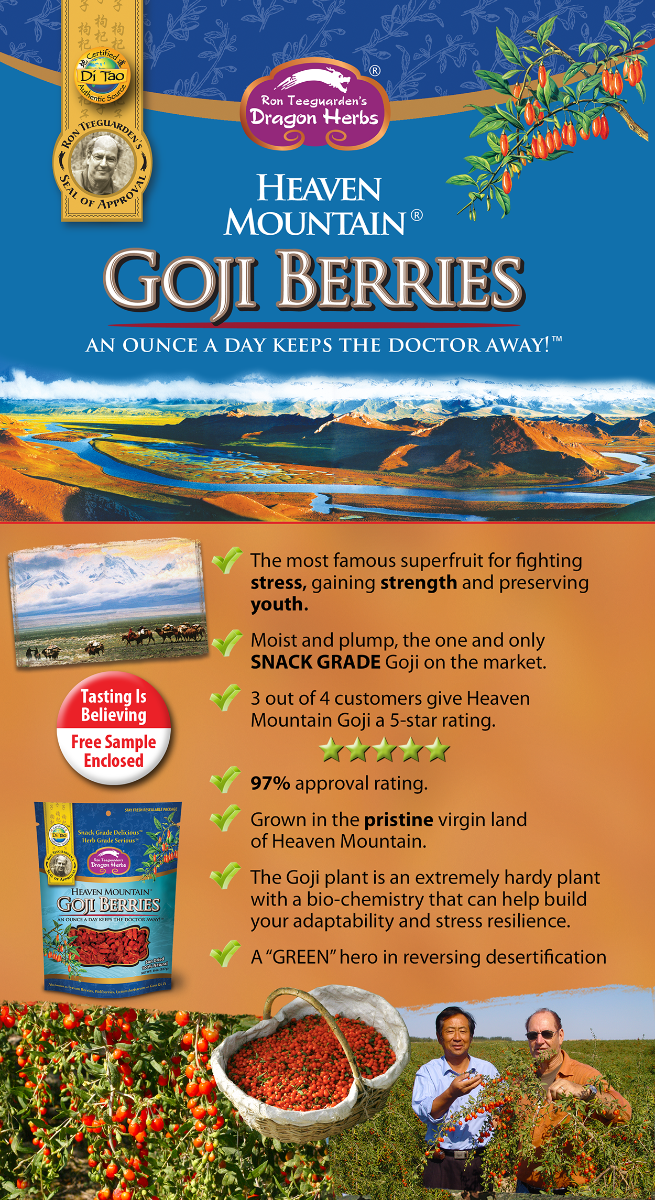
Heaven Mountain® Goji Berries are Herb Grade Serious™
Goji’s health benefits are well documented by numerous research studies conducted across the globe. In the West, there has been ample media coverage on Goji in recent years. For an up-to-date summary of its health benefits, please email us at info@dragonherbs.com.
What you probably don’t know are the stories of Goji and two of the most famous herbalists in Chinese herbalism who are also the most revered experts in the art of longevity. As authors of herbalism, they knew everything there was about every herb and they had access to all of them. Both chose to consume Goji daily throughout their entire lives and both lived famously to very old age (101 years and 80 years). Please bear in mind that around 500-600 AD, the average life expectancy was only 27 years. As recent as the 18th century, the average lifespan barely increased to around thirty years. The longevity of these great herbal masters fifteen hundred years ago is truly remarkable.
Today, the average life expectancy is around 70 years. According to the biology principle, mammal’s lifespan is about 5-7 times its growth period. The human growth period ranges from 20 to 25 years, so the shortest human lifespan should be 100 years, and the longest should be 175. The consensus is 120 years. So why don’t the majority of us reach 120? After 1500 years of evolution, maybe we should all learn something new from the old masters?
Tao Hong-Jing (456-536 A.D.)
A Taoist master who specialized in the study of herbs, Tao compiled the “Commentary on Shen Nong’s Materia Medica”, one of the most valuable books on medicinal and tonic herbs in China’s history. He also authored “Recordings of the Art of Health and Life Preservation” in which he declared that life is in the hands of people, not God. Tao Hong-Jing drank Goji tea every day. He lived to be 80 years old.
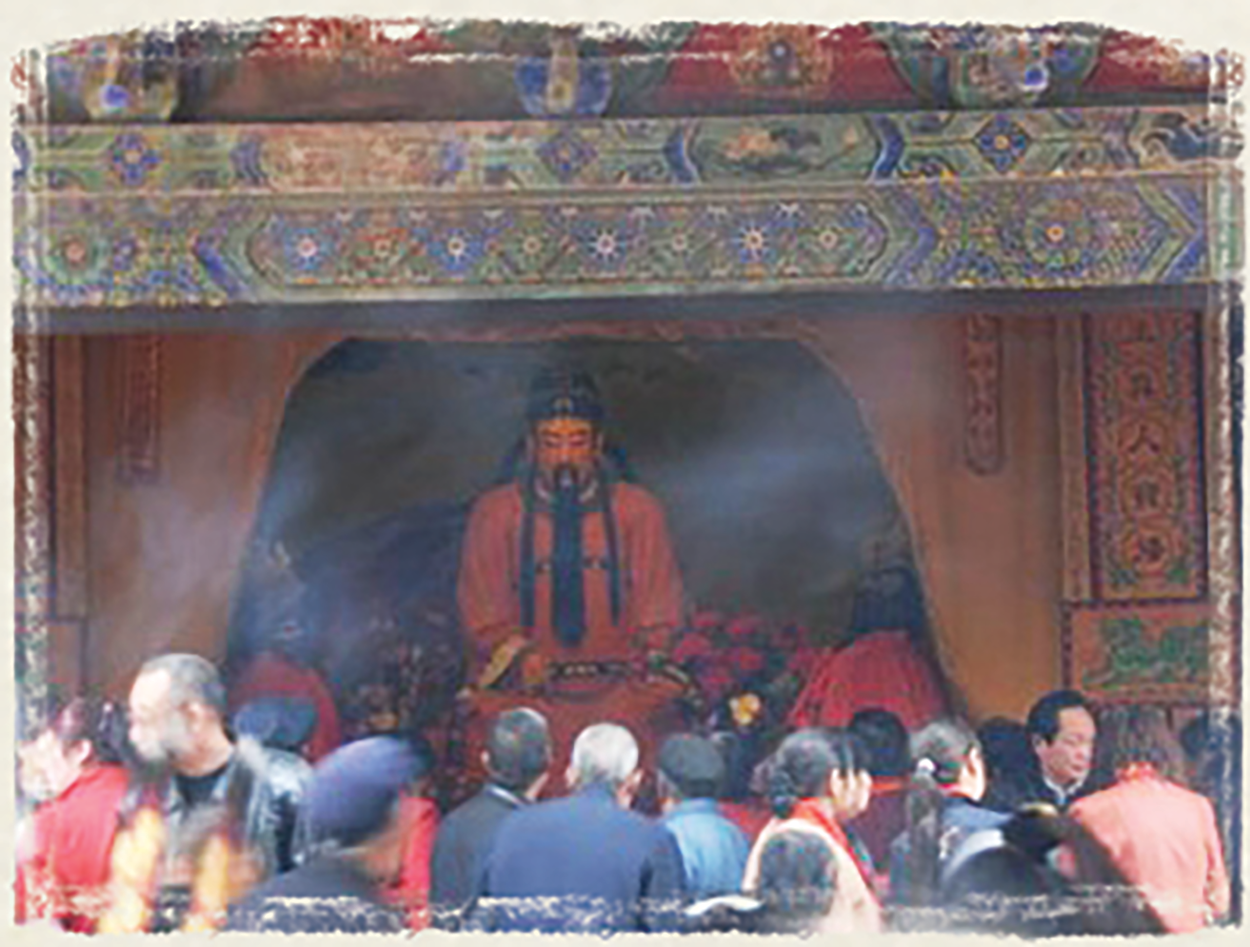
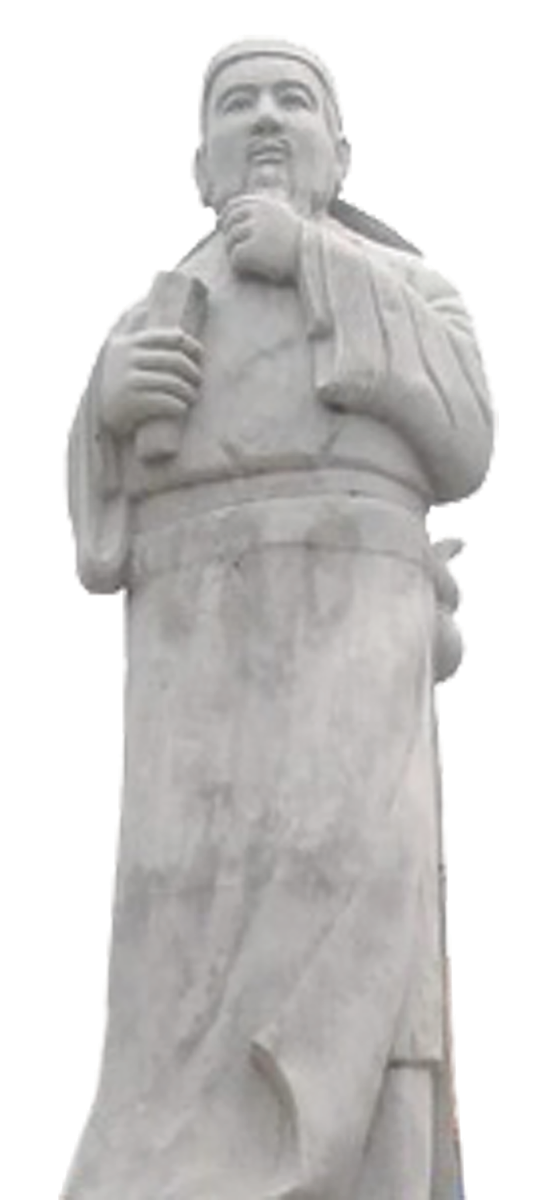
Sun Si-Miao (581-682 A.D.)
Sun Si-Miao is known as the Herb King. Sun lived to be 101 years old. He was born with a very weak constitution and was very sickly in his childhood. His family was almost bankrupted by his medical expenses. In pursuit of health, he started to study herbalism at an early age. Sun ended up devoting his entire lifetime to the art of medicine. His monumental books, “Prescriptions Worth a Thousand Pieces of Gold” and “Supplement to Prescriptions Worth a Thousand Pieces of Gold,” have been regarded as a compendium of China’s medical achievements up to the 7th century. Sun believed if his work could save a single life, it would surpass the benefaction of a thousand pieces of gold. He wrote his first book at the age of 71, and he finished his “Supplement” book at the age of 100. A year later, he died peacefully. This is not just longevity, this is vigor at an advanced age. Because of his weak constitution, Sun Si-Miao was a very disciplined practitioner of the art of life preservation, and he consumed Goji every morning and every night throughout his entire life. He was as famous for his longevity as he was for his work. His secrets for achieving centenarian status 1500 years ago remain a hot topic today.
Goji Berries’ Treasure Rating and the Three Treasures of Tonic Herbalism----an Overview
Traditionally in Tonic Herbalism, there are said to be three primary types of energy in the human body, and the same is true throughout nature. These three energy categories are known as the “Three Treasures,” Jing, Qi (pronounced chee) and Shen. These energies are called “treasures” because they are the very basis of our life. Tonic herbalism uses tonic herbs containing either one or several of these treasures to help replenish and re-balance the Three Treasures so that a dynamic balance between Yin and Yang can be established and maintained and that homeostasis can be achieved. Treasure Rating scores the amount of each treasure the tonic herbs contain on a scale of 0-5, 0 being the lowest, 5 being the highest. A simple analogy by which one can understand the Three Treasures Paradigm is to think of life being like a candle.
Jing is the candle. It is the deepest source of energy in the body and is associated with our genetics. It is our reserve of life force. It determines how long we live and the power of our life. In Asia, Jing is associated with regeneration, longevity, youthfulness, deep long-term vitality, mental energy, the source of power for the reproductive system and for optimal functioning of the immune system. Jing energy also supports our skeletal system, renal functions and our ability to hear. Jing is believed to govern our courage and is the power behind our will. Jing energy is depleted by living itself, but most especially by stress, excessive behavior, and overwork. Jing is divided into two Categories. Yin Jing and Yang Jing. The secret of rejuvenation and maintaining our health lies in rebuilding the right balance of Yin and Yang. Yin Jing herbs replenish spent Yin Jing and build reserves for future use. They are deeply nourishing, generally moistening and are believed to be youth preserving. Yang Jing herbs replenish spent Yang Jing. They are deeply empowering. They rekindle the fire of life where it has been spent and invigorate vigor at the deepest levels.
Qi is the flame. It is the energy of life, acquired through breathing and eating and manifested as our day-to-day vitality, our innate ability to defend ourselves, our adaptability to changes and our blood. Qi herbs replenish Qi.
Shen is the light given off by the candle. It is our spirit, our state of psychological wellbeing, our wisdom, and our spiritual experience and radiance. Shen herbs replenish Shen.
Goji is among the top 5 tonic herbs(Cordyceps, Ginseng, Schizandra, Deer Antler) that score high on almost all categories of the Three Treasures. Millions of people throughout Asia consume Goji berries every day for both their unique, satisfying flavor, and for their health benefits. In China’s first herbal encyclopedia, Shen Nong’s Materia Medica, written in the 1st century B.C., Goji was classified as a “superior tonic,” a class of herbs that people should take on an on-going basis to preserve youth and to promote general well being. Goji’s superior tonic classification has stood the test of time. Two thousand years later, Goji berries are still being consumed regularly around the world for those very same reasons. We now know that Goji berries are a “high-ORAC” antioxidant-rich superfruit/tonic herb featuring important phytochemicals such a beta-carotene, zeaxanthin, betaine, unique immune-potentiating polysaccharides (LBPs), trace minerals and vitamins.

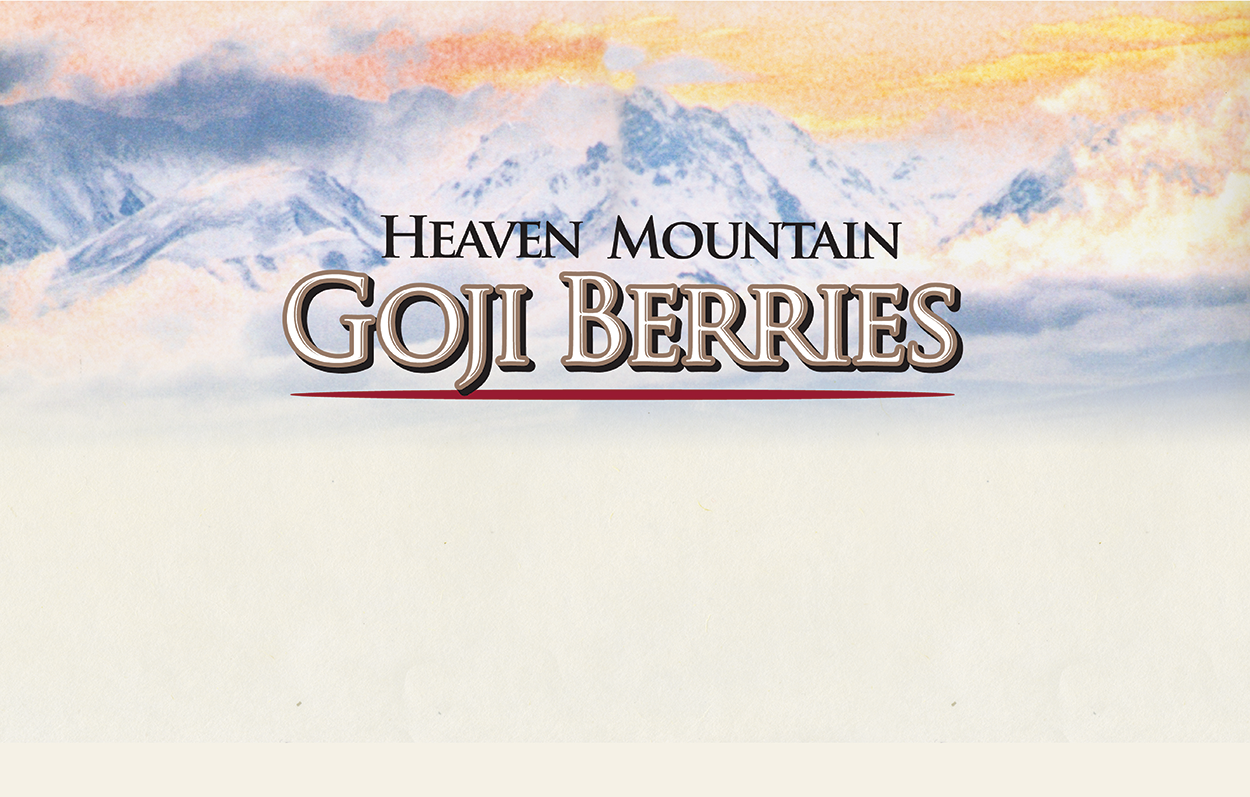
Heaven Mountain® Goji Berries, the only Goji berries that are snack-grade delicious™.
Heaven Mountain® Goji Berries are plump, moist, naturally sweet, and absolutely delicious. In comparison to other Gojis on the market, Heaven Mountain® Goji Berries are sweeter, fleshier and have less seeds. They have a much higher moisture level which contributes to their plump and moist texture.
Most Gojis on the market are rock hard. This is not without a reason. All the Goji sold in the US comes from China, even if it is labeled as Himalayan or Tibetan. That translates to a very long transit time from the growing regions to the hands of the consumers. Typically, the berries reach the consumers at least 4-6 months after they are harvested. To keep the berries shelf stable for the overseas market, importers have the Goji farmers dry their Goji until it is bone dry and rock hard. The majority of the moisture is removed, resulting in a hard, leathery texture.
After years of research and development, Dragon Herbs has developed a special handling process and custom designed packaging that allow the berries’ natural moisture level to be retained while satisfying the shelf stability required for modern commercial trade.
In a test conducted by an independent lab, Heaven Mountain® Goji Berries are shown to be twice as moist as a competitor’s.
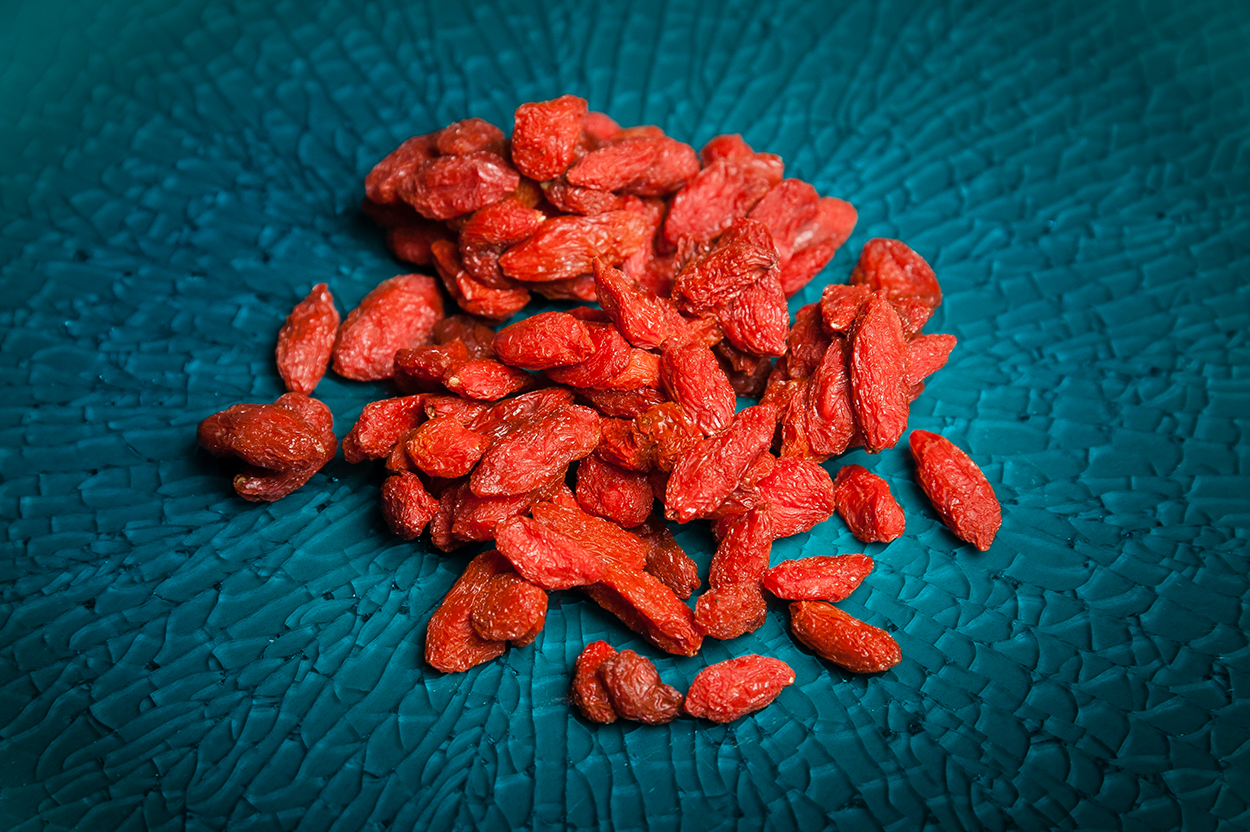
“I have tried about 6 brands of goji berries and this one is by far the best.” Massachusetts
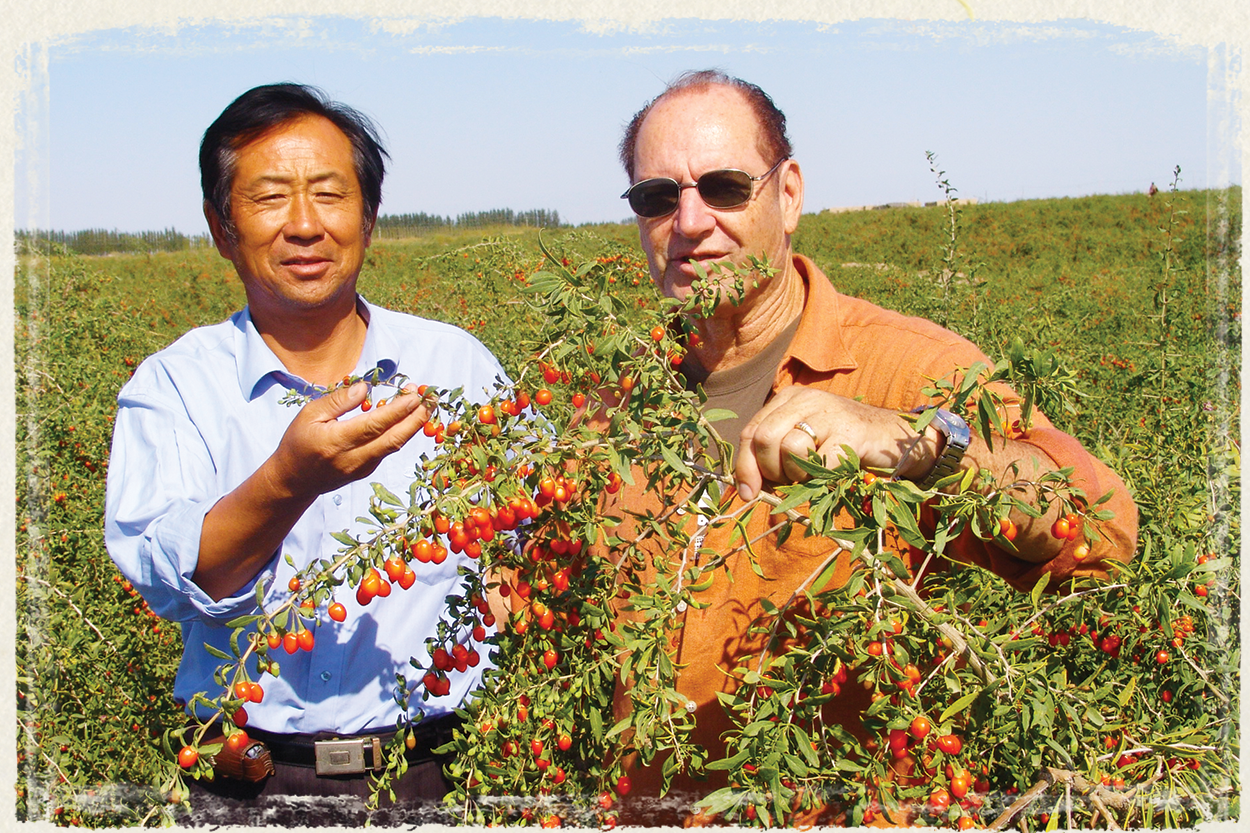
Ron Teeguarden with a Goji farmer inspecting Goji berries.
What makes Heaven Mountain® Goji Berries so special? Simply put, Heaven Mountain.
Heaven Mountain is a remote mountain range in the northern region of Xin Jiang Province, China. The concept of Di Tao used in the world of herbalism can best describe the relationship between the geographical and geological features of the region and the phytochemical profile of Heaven Mountain® Goji Berries.
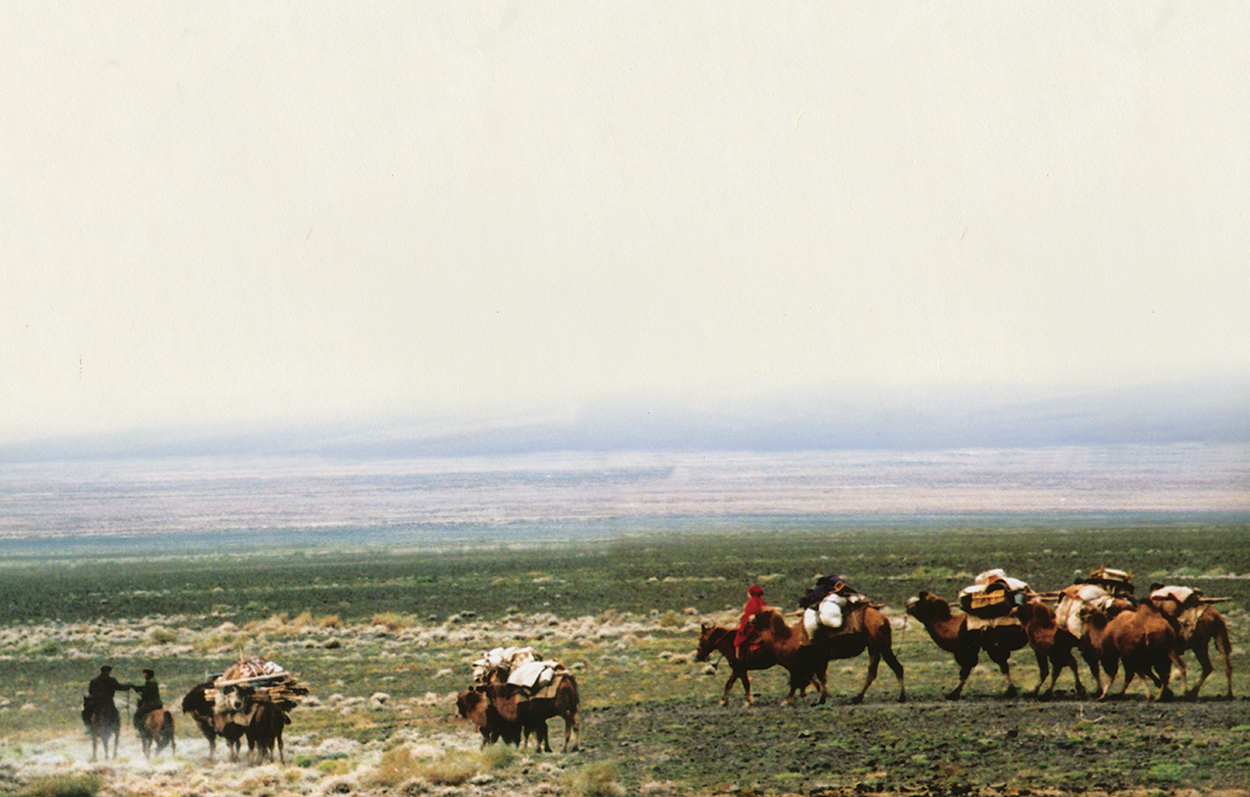
The “Di Tao” of Herbs
There is a great concept in Chinese Herbalism known as
Di Tao™. The literal translation of Di Tao is “Earth Tao,” or “the Way of the Earth.” The Chinese dictionary definition of Di Tao is “from the place noted for the product ~ genuine, authentic, not from an inferior or counterfeit source.” According to the regulations of the Chinese Pharmacopeia, all herbal products manufactured and sold in China must utilize herbs that are Di Tao - that is, the herbs must come from a source that is considered legitimate and genuine.
All plants are the product of their growing environment and conditions. Different regions have their distinctive make-up of water, soil, sunshine, climate, and biological distribution. The varying methodologies adopted by different regions in their cultivation, collection, and final preparation of the herbs further differentiate the herbs from different sources. The Di Tao source of an herb is gradually established through its historical use. By documenting how herbs from different origins differ in their pharmacological effects on the human body, the regions or sources that produce the most desired results have slowly come to be recognized as the authentic, genuine source, Di Tao, both by common knowledge among practicing herbalists as well as by government supported official recognition in the materia medica.
Heaven Mountain® Goji Berries are one such example of Di Tao. The water, the soil, the sunshine and the weather at the pristine foothills of Heaven Mountain have the precise qualities necessary for producing the best, richest, tastiest, most powerful Goji berries on Earth. As a result, they have an extraordinary and balanced phyto-nutrient profile
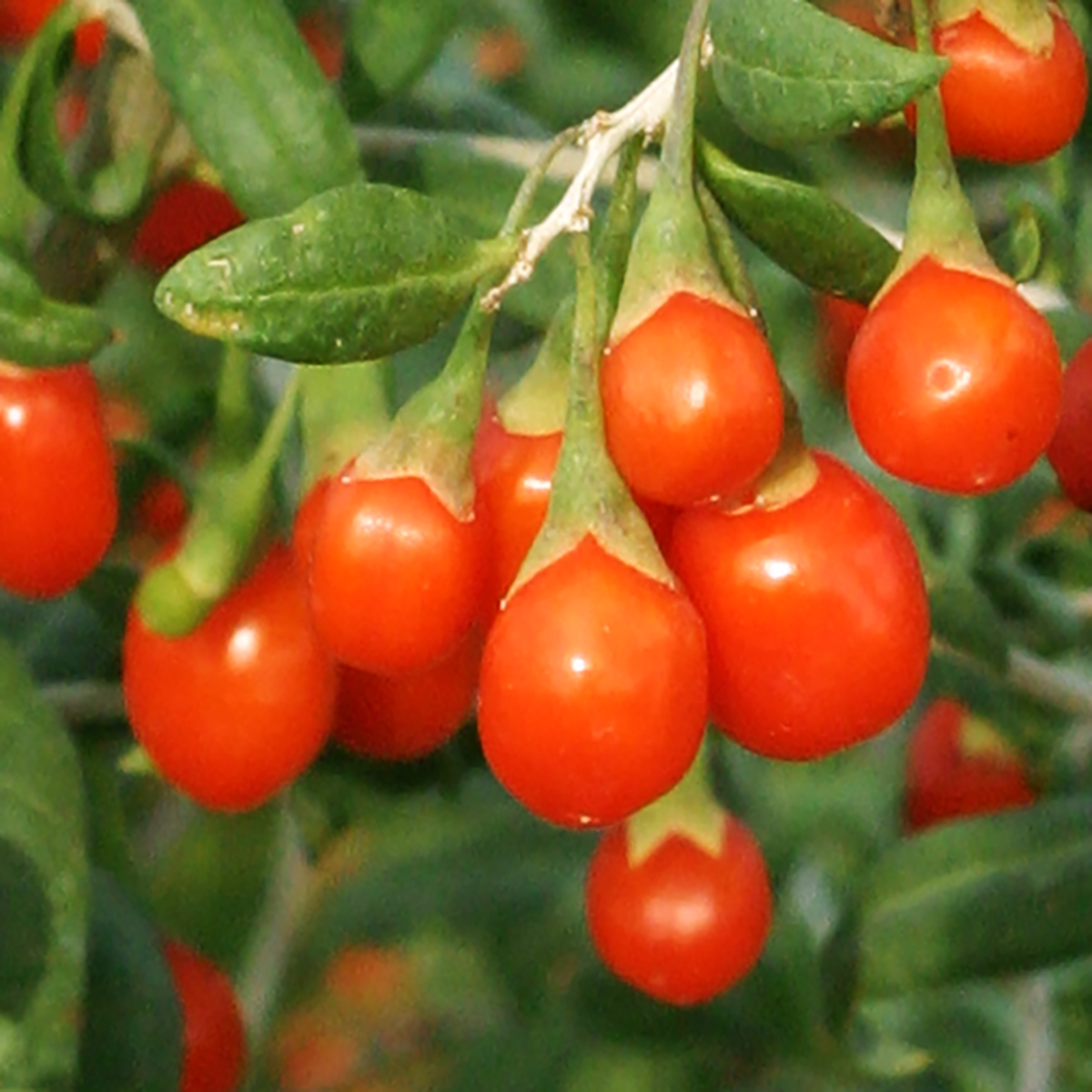
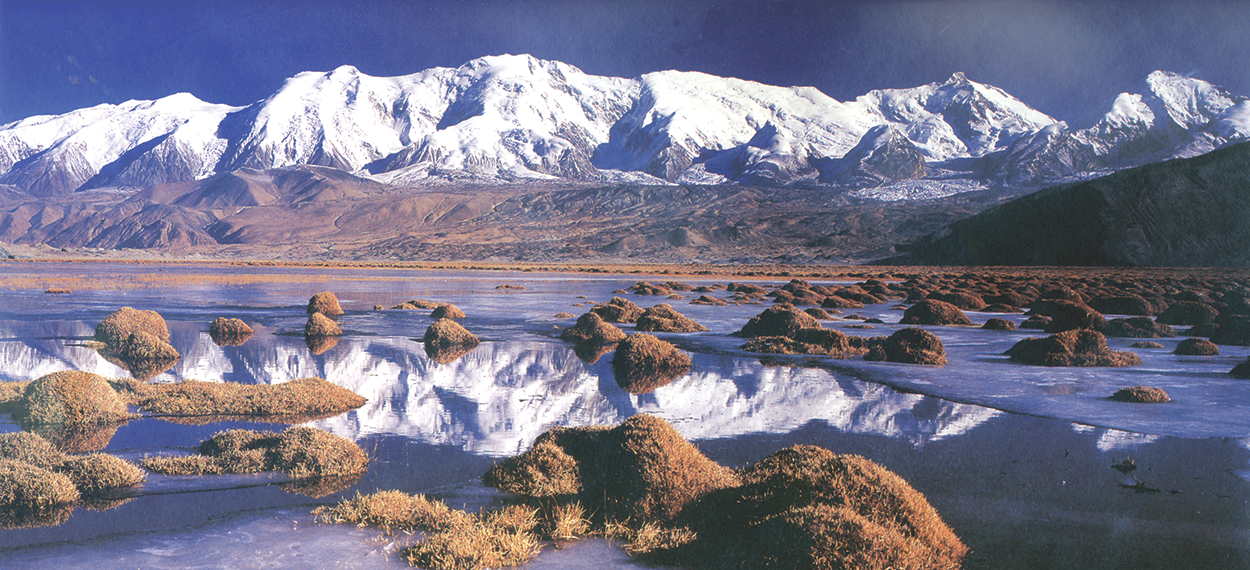
Snow and glacier mountain runoff from Heaven Mountain.
Water
At the edge of the enormous Gobi Desert that covers southern Mongolia and northwestern China, the Goji producing region of Xin Jiang receives little to no rain throughout the year. Every drop of water in the growing fields is derived from the melted snow and glacial runoff from the pristine Heaven Mountain. This water is pure and structured – it is nature’s ultimate irrigation system.
Soil
The virgin land at the edge of the Gobi Desert has little vegetation. It has a very high content of alkaline minerals. The pH level of the soil can be as high as 8.7 (50 times more alkaline than water) and the soil salt can reach a very high content of 1%. Few plants can survive in this kind of harsh environment. Goji, however, being an extremely adaptable plant, thrives here. Not surprisingly, Goji berries are an alkaline food.
Daylight Duration
Xin Jiang province has the longest daylight duration among all provinces of China (Tibet included). It averages 2550 to 3300 hours of sunshine per year. The intensive sunlight allows for unusually productive photosynthesis in the Goji plants, leading to more flesh, sweeter taste, and naturally higher content of active ingredients such as Lycium Polysaccharides (LBP).
Precipitous Daily Temperature Fluctuation
Another unique weather characteristic of Xin Jiang is the precipitous temperature fluctuation between day and night, usually as much as 36 to 45° F within a single day. The locals joke that in Xin Jiang, no traveling is necessary in order to experience all four seasons within one day. It is quite common that people start their day with winter jackets, strip down to silk shirts at noon, then at night, they can enjoy their famous watermelons, next to a bonfire.
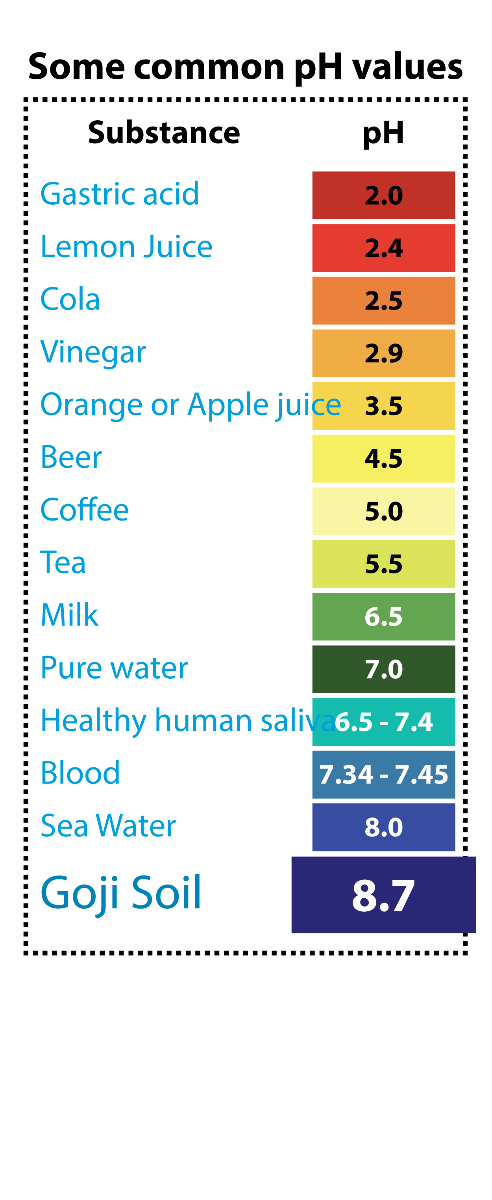
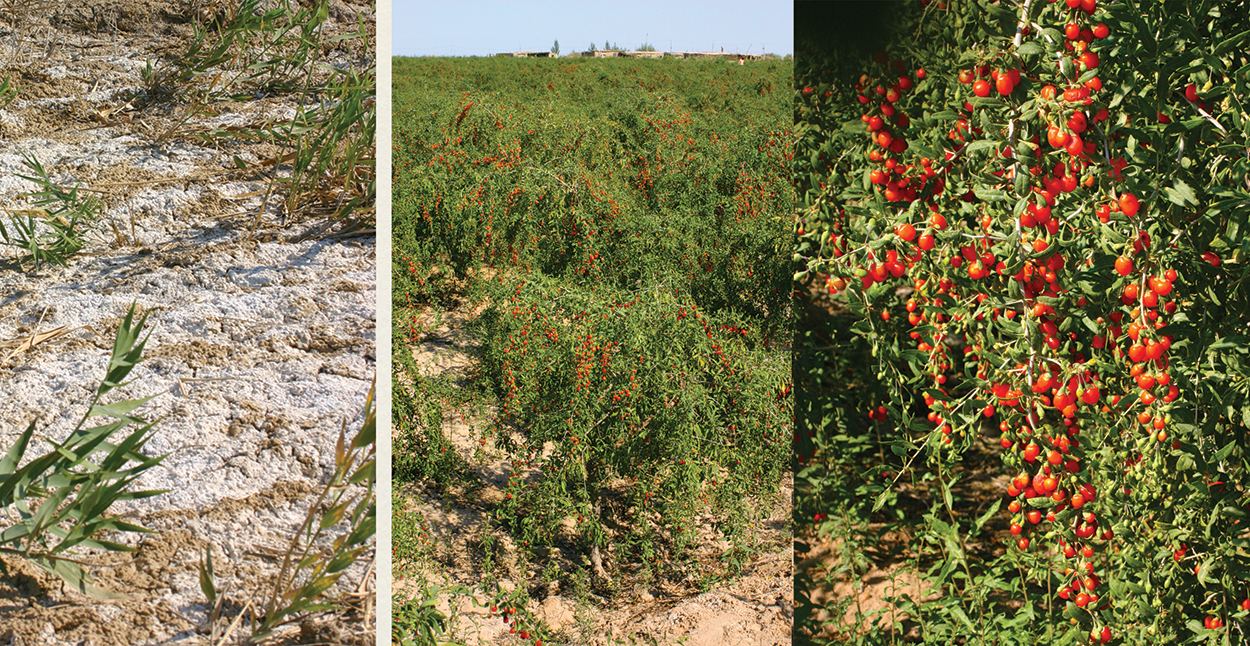
What does the fruit of a hardy plant such as Heaven Mountain Goji mean to us humans?
We are what we eat. The plants’ bio-chemistry transports to our body when we consume it. A Ginseng root grown in the mountain is hundreds or even thousands of times more expensive than a cultivated Ginseng root because the wild root has to endure a tremendous amount of distress in order to survive in the wilderness. The result? Survival of the fittest. The more hardship a plant endures, the more complex, complete and balanced its phyto-chemical profile becomes. It is Heaven Mountain Goji’s superb adaptability, the ability to thrive in its extremely harsh environment that makes this little red berry a highly revered adaptogenic, stress-fighting tonic herb.
Heaven Mountain® Goji Berries,
a GREEN hero in reversing desertification.
Not only are the Heaven Mountain® Goji Berries good for you, they are good for the Earth as well.
Because of Goji’s superb adaptability, it thrives where other plants fail to survive. The Goji plants are drought tolerant, cold and heat resistant, and they can endure, and even flourish in, saline and alkaline soil. Goji plants have highly developed root branches which bind firmly with the soil. Many Goji trees are being planted in northern and western China as a wind breaker, sand binder and soil ameliorator as part of a government supported program to reverse desertification.
Himalayan Goji, a myth still to be demystified.
Whether or not Himalayan Goji is sourced from the Himalayas is still being debated. The Gojis that do come to the West all share one country of origin, China. Many Goji berries are labeled as “Himalayan,” some labeled as “Tibetan Wild
